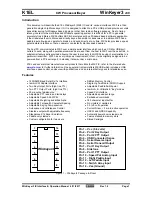
TKMnC3 Register
Bit
7
6
5
4
3
2
1
0
Name
D7
D6
MnRCOV
Mn16CTOV
¾
MnROVS2
MnROVS1
MnROVS0
R/W
R
R
R
R/W
¾
R/W
R/W
R/W
POR
0
0
0
0
¾
0
0
0
Bit 7~6
D7, D6
: Read only bits -- unknown values
Bit 5
MnRCOV
: Time slot counter overflow flag
0: no overflow
1: overflow
Bit 4
Mn16CTOV
: 16-bit C/F counter overflow flag
0: no overflow
1: overflow
Bit 3
Reserved bit, must not be modified.
Bits 2~1
MnROVS2
~
MnROVS0
: Time slot counter overflow time setup
000: 64 count
001: 128 count
010: 256 count
011: 512 count
100: 1024 count
101: 2048 count
110: 4096 count
111: 8192 count
Touch Key Operation
When a finger touches or is in proximity to a touch pad, the capacitance of the pad will increase. By
using this capacitance variation to change slightly the frequency of the internal sense oscillator, touch
actions can be sensed by measuring these frequency changes. Using an internal programmable divider
the reference clock is used to generate a fixed time period. By counting a number of generated clock
cycles from the sense oscillator during this fixed time period touch key actions can be determined.
The device contains four touch key inputs which are shared with logical I/O pins, with the desired
function selected using register bits. The Touch Key module also has its own interrupt vectors and set
of interrupts flags.
During this reference clock fixed interval, the number of clock cycles generated by the sense oscillator
is measured, and it is this value that is used to determine if a touch action has been made or not. At the
end of the fixed reference clock time interval, a Touch Key interrupt signal will be generated.
BS83B08-3/B12-3/B16-3/B16G-3/C24-3
8-Bit Touch Key Flash MCU
Rev. 1.50
79
April 28, 2020
















































